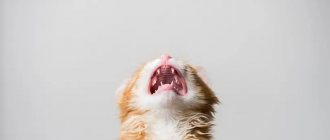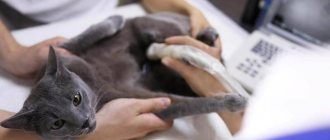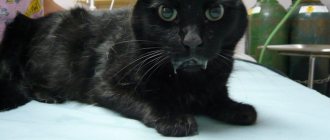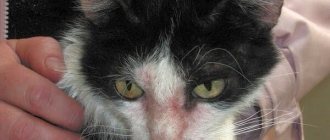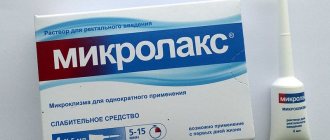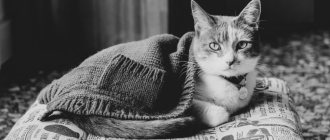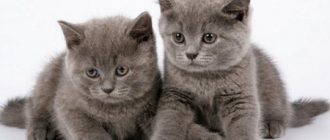The situation when a cat does not go to the toilet for a long time is quite common. There can be many reasons for such a deviation - from the most harmless to the very serious. Owners should remember that a healthy cat defecates approximately once every 1-2 days. In older animals, the period between bowel movements can stretch up to three days, but small kittens usually poop several times a day.
The frequency of trips to the toilet largely depends on the characteristics of the pet’s diet. However, if 3 or more days or even a whole week have passed since the last visit to the tray, you should be wary. Constipation may indicate serious health problems. It is imperative to find out the cause of the deviation and help the cat.
© shutterstock
About the causes of constipation
Prolonged absence of bowel movements is an alarming symptom; the condition can be accompanied by severe pain. Feces accumulated in the gastrointestinal tract can, over time, cause inflammatory processes, intoxication of the body, and in severe cases lead to complete intestinal obstruction. In the latter case, death is possible.
Delayed defecation has a clear gradation in medicine; it is divided into:
- According to the organic mechanism of action.
Feces are retained in the intestines due to physical obstacles in the form of tumors, neoplasms, and scars.
- According to the functional mechanism of action.
The cat stops going to the toilet due to insufficient activity of the gastrointestinal tract. Reasons: sedentary lifestyle, inappropriate food, inflammation, intoxication, metabolic disorders, chronic diseases.
Also, a distinction is made between partial stool retention (feces are excreted in a minimal amount, the bulk is retained in the body), and complete stool retention (feces remain completely in the intestines).
Additional symptoms to watch out for:
- Painful bowel movements - the animal screams during bowel movements and experiences pain when palpating the abdomen. Possible causes: gastroenteritis, diseases of internal organs, mechanical damage to the pelvis.
- intense bowel movements - a small predator often visits the toilet, feces come out in small portions or there is no bowel movement at all. Constipation gives way to diarrhea, stool has a liquid consistency. Possible causes: gastroenterocolitis, enterocolitis.
Problems with bowel movements often occur as an additional symptom to chronic diseases.
- Inflammatory processes in the gastrointestinal tract develop due to irregular nutrition, too cold or hot food, monotonous diet, poisoning, allergic reactions, parasites, infections. The disease is accompanied by constipation, vomiting, loss of appetite, and aggressive behavior of the animal.
- Inflammation of the pancreas (pancreatitis) develops both as an independent disease and in the case of parasitic infection. Signs: lack of bowel movements, loss of appetite, pain, bloating in the abdominal area.
- Increased gas formation is observed in animals due to improper feeding. Flatulence is accompanied by constipation, the stomach swells and becomes hard, the pet experiences pain and screams.
- Gastrointestinal blockage develops due to hairballs trapped in the stomach; bones for food; sedentary lifestyle; foreign objects swallowed by the cat. Signs: feces are not excreted, colic occurs, the pet’s behavior changes, pain and vomiting occur after eating, the stomach is bloated.
- Excess weight (obesity) occurs due to an unbalanced diet, problems with the liver, and endocrine system. The process of defecation occurs rarely, the pet leads a sedentary lifestyle.
- Lack of weight (dystrophy) develops due to a lack of nutrients in feed. The small predator has virtually no defecation, the animal is extremely thin, the fur is dull, and the mucous membranes are bluish in color.
- Helminth infestation. When infected with helminths, a pet loses weight, refuses food or eats excessively, constipation gives way to diarrhea, behavior changes, the stomach increases in size, and itchy sensations appear in the anus.
Be sure to read:
Urinary incontinence in a cat: causes and treatment, symptoms, medication and alternative treatment
Treatment of constipation with various drugs is directly related to the causes of the unpleasant condition.
Why doesn't my little kitten poop?
Kittens that are still under the “wing” of their mother are completely dependent on her in this delicate matter. Babies under one month old can poop normally only after the cat massages their tummy.
If such a baby does not go to the toilet for a long time, it means that the mother is not coping well with her responsibilities. This often happens to young, inexperienced cats “raising” their first litter. Causes of constipation in older kittens may include :
- severe stress due to weaning from mother and moving to a new place of residence;
- a sharp transition to a new type of diet (from milk to solid food);
- unsuitable food;
- congenital intestinal pathologies.
If quite a lot of time has passed since moving to a new home, and the baby still hasn’t gone to the toilet, and adjusting the diet does not help, most likely, the last of the listed points is occurring. The kitten should definitely be shown to a veterinarian. Serious treatment may be required, including surgery.
© shutterstock
How often should a cat go to the toilet?
Defecation rate for cats:
- Adult pet - 1 time per day.
- Kitten - 1-2 times a day, kittens have an increased metabolism, food is digested faster.
- Elderly animal - 1 time in two days; in pets older than 6 years, the metabolism decreases.
According to veterinarians, constipation is considered to be a delay of three or more days. Associated symptoms: anxiety, lack of appetite.
Doctors recommend examining your pet's stool to identify the disease at an early stage. In a healthy cat, feces are oblong in shape, dark brown in color, and soft in consistency.
Deviations:
- overly dry, cracked “balls”,
- liquid consistency,
- unusual color (gray, yellow, red),
- presence of foreign inclusions
Selecting a location
How to train a kitten to use a litter tray? If you are just planning to take a baby, then you need to immediately approach the responsible task correctly. The first purchase for a kitten, of course, is a tray, which it is advisable to choose correctly.
Let's look at some types:
- The cheapest option is a plastic tray with low sides. It washes well and takes up little space, but a significant drawback is that it is used together with filler granules, which the kitten can scatter or eat (you need to think about eating in advance).
- Tray with mesh. Can be used without filler. It has high sides. Cats like these because they look like boxes.
- Tray in the form of a house (closed type). The advantage of such a device is its aesthetics, the disadvantage is the high cost of the device.
- Self-cleaning tray. This option has a number of positive qualities: the cleanliness of the tray does not require the owner’s attention; no odor; Four pets can go into this tray; presence of a motion sensor; safety of capsules. The negative aspects are: connection to water supply and electricity, noisy flushing, which can frighten the animal.
First aid for constipation
You can quickly help your cat at home by giving the animal an enema or inserting a rectal suppository into the anus.
Rectal laxatives with glycerin for humans can also be used for cats. Half a candle is placed on the cat. Cut the candle lengthwise, carefully insert it into the anus, hold the pet in your arms, stroking the belly in a circular motion to stimulate peristalsis. Repeat the procedure after 4-5 hours; if there is no bowel movement, administer an enema.
How do you know if a massage has helped?
Since it is very easy to massage a cat with constipation, feel free to use this measure - often it is enough to help the animal. If you are afraid to carry out any manipulations yourself, it is better to seek help from a specialist. The same should be done if the condition worsens or there are no results after the massage.
Conclusions about whether a massage will help your pet can be made while it is being performed: if you hear rumbling or gurgling in the cat’s stomach during the procedure, this means that peristalsis has improved and the intestines are about to resume their work. If you did everything correctly and the problem is not obstruction, the processes of the digestive system should return to normal within 2-3 days.
Treatment at home
In the initial stage, you can get rid of the problem at home.
- Changing your diet.
You need to start feeding the cat fractionally liquid food (5-6 times a day), the portions should be small, you should add a little vegetable oil and bran to the food.
- Feeding with vegetables.
You need to add raw carrots and beets, chopped in a blender, to your daily food. If the cat does not want to eat vegetables, you should squeeze out the vegetable juice through gauze and inject it into the mouth through a syringe without a needle.
- Introduction to the diet of foods that normalize digestion.
Be sure to read:
A cat poops blood: causes, treatment methods, what to do before seeing a doctor, when to sound the alarm
Fermented milk products with low fat content (kefir, fermented baked milk, yogurt) can normalize the animal’s digestive processes.
- Daily massage.
You can massage your cat's belly daily, stroking it clockwise with force.
Special diet
Regardless of the diagnosis, a sick cat will need a corrective diet. It is necessary to exclude from the animal’s diet foods that irritate the kidneys and organs of the urinary system.
Cheap dry food of the “economy” and “premium” classes is prohibited. These products contain a lot of salt, preservatives, flavors and dyes. Of the expensive dry food, only special brands designed for animals with urological diseases and urolithiasis are allowed.
Foods that should not be given to sick cats:
- Pork is a fatty meat that thickens urine.
- Milk is a source of magnesium, which obstructs the flow of urine.
- Salt.
- Raw fish contains phosphorus. May cause the formation of stones in the bladder.
- Raw meat. Protein foods overload the kidneys.
Until the animal’s condition stabilizes, the cat’s diet should be light, high-calorie and natural. It is imperative to ensure compliance with the drinking regime - the cat should always have a sufficient amount of fresh drinking water.
Laxatives: Top 5
- Medicines based on lactulose (Dufolak, Romfalak, Gudalak). The drugs can be used for a long time, the drugs are suitable for animals, have a gentle effect on intestinal motility, and are safe for health. Bowel movement occurs within 2-3 hours, taken in the morning and evening, single dose - 0.5 mg per kilogram of weight.
- Magnesium sulfate solution. The product acts on receptors in the walls of the gastrointestinal tract, effectiveness is achieved after 7-10 hours. single dose - 2-4 mg.
- "Ramnil" is a medicine made from buckthorn bark. The drug in tablet form is given to the animal once a day. A single dose is half a tablet.
- Carlsbad salt solution. The product helps improve digestion processes and leads to gentle bowel movements. Dilute a tablespoon of powder in 100 ml of water and give to the cat 2 times a day.
- "Izafenin". Taking the powder helps cope with chronic constipation and is used as prescribed by a veterinarian.
Factors causing the problem
Impaired bowel movements can occur if the following factors are present:
- Acute intestinal obstruction. The problem develops if a foreign body (fur, swallowed paper or cellophane) interferes, and intussusception occurs.
- Neoplasms in the colon. This can cause compression of the intestinal lumen and block the passage of stool.
- Inflammatory pathologies in the intestines.
- Problems with the anus. Due to mechanical damage to the sphincter (for example, scar deformation), defecation may be difficult.
- Disturbed diet. Lack of fiber and water, consumption of dry food can provoke excessive dryness of feces, which impairs its excretion.
Enema
The procedure is carried out as follows:
- Prepare an enema solution. Dissolve a pinch of salt in warm water. Take an enema.
- Lubricate the animal's anus and the enema tip with Vaseline oil.
- Slowly insert the tip into the anus (in a circular motion).
- Pour in the solution.
- Remove the enema, press the pet's tail to the anus, hold it in your arms for 10-15 minutes.
Be sure to read:
Black feces in a cat: normal or pathological, when is it a dangerous symptom, diagnosis, how to treat
Preventive measures
If a cat does not poop for a long time, owners begin to wonder what to do if the cat is constipated. As with any other disease, it is easier to prevent than to cure.
Therefore, we simply monitor the diet of our pets, give them food containing fiber more often, mix in vegetables, and also organize access to fresh green grass. It gets rid of hair accumulated in the stomach and helps protect against obstruction.
The cat must have plenty of clean water, it must lead an active lifestyle, and its owners must monitor the pet’s weight. If you have the slightest health problems, you should contact a veterinary clinic, then there will be much less chance of developing any disorders or diseases.
Vaseline oil for constipation
Vaseline oil is a safe remedy that is given to a cat when there are problems with the intestines. The product can be injected through a syringe into the anus; another option is to inject it into the mouth through a syringe without a needle.
The oil can soften feces. move feces through the intestines. The pet's intestines are emptied 3-5 hours after the administration of the oil. single dose - 3-5 ml.

